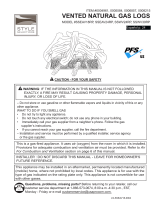
Principle of Operation
Regulator
The regulator is operated by initial steam or uid
pressure. It is normally closed, being held so by initial
pressure on the disk and by an internal main spring,
see Figure 3. When the pilot is opened (see pilot
instructions), initial pressure ows through the pilot
to the 8B tee. 4A bleed port restricts the ow and
pressure builds under the diaphragm and opens the
main valve.
Delivery pressure feeds back through the control pipe
to the pilot diaphragm. As this pressure approaches a
balance with the thrust of the adjusting spring, the pilot
throttles the loading pressure. In turn, the main valve
takes a position established by the loading pressure
where just enough steam ows to maintain the set
delivery pressure.
Condensate Chamber
Main valves with large internal volumes, or valves
used in relatively high pressure or superheat, may
require more water than can be condensed from
radiation alone. Live steam will rapidly degrade the
rubber diaphragm of a Type E5 and generally yield
poor control in other main valves. To prevent this
from happening, the Condensation Chamber and
the base are primed with water before start-up. As
the pilot opens, medium pressure steam ows to the
Condensation Chamber condensing the vapor in the
presence of the prime and larger radiational area.
The condensate exits the chamber through a No. 5B
Open Elbow directed to the No. 5A Restriction Elbow
in the hood. This condensate collecting under the
diaphragm creates a loading pressure which forces the
valve open.
Installation
▲ WARNING
Personal injury or system damage
may result if this regulator is installed,
without appropriate overpressure
protection, where service conditions
could exceed the limits given in
the Specications section and/or
regulator nameplate.
Additionally, physical damage to the
regulator may result in personal injury
or property damage due to escaping of
accumulated gas. To avoid such injury
and damage, install the regulator in a
safe location.
Under enclosed conditions or indoors,
escaping gas may accumulate and be an
explosion hazard. In this case, the vent
should be piped outdoors.
For regulator constructions with a
spring case vent, the vent should be
kept open to permit free ow of gas
to the atmosphere. Protect openings
against entrance of rain, snow, insects
or any other foreign material that may
plug the spring case vent or vent line.
All pressure equipment should be installed
in a non-seismic area; should not be
exposed to re; and should be protected
from thunderbolt (lightning) strikes.
Planning
• Locate the valve in a straight run of horizontal pipe.
• Allow headroom above the valve for access through
the blind flange.
• Provide clearance for stem withdrawal underneath.
• Prevent water hammer and erratic operation by
installing traps to provide proper drainage before
and after the valve and before secondary pressure
relief valve or control valve.
• Avoid damaging effects of scale and dirt in the pipe
lines by using a strainer as shown in Figure 2.
• Provide a three-valve by-pass to facilitate
inspection without interrupting service.
• To eliminate excessive noise and erratic regulation
with steam and other compressible fluids, enlarge
the delivery pipe size to effect a reasonable
flow velocity at the reduced pressure. A tapered
transition is recommended.
• If possible, avoid a sharp turn close to the regulator
outlet and a bull-headed tee connection to the low
pressure main.
• Install initial and delivery pressure gages to
indicate performance.
• If the pressure rating of the delivery system or
connected equipment is less than the initial steam
pressure, provide a safety valve.
3
Type E5

















